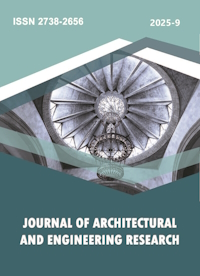Influence of Thermal Insulation Materials on Natural Gas Consumption under Cold-Climate Conditions
DOI:
https://doi.org/10.54338/27382656-2025.9-04Keywords:
heating, energy, climate, data, efficiency, thermal insulation, sustainabilityAbstract
This article presents a comprehensive and in-depth study focused on improving the energy efficiency of residential buildings in cold-climate regions, using the town of Sisian in Armenia’s Syunik Province as a case study. The primary objective of the research is to evaluate the effectiveness of thermal insulation applied to the external load-bearing structures, specifically the exterior walls and roof of a typical two-story residential house. The study emphasizes the use of polyurethane foam, a modern insulating material known for its high thermal resistance, durability, and ease of application. The research was conducted during the heating season, a period marked by high energy consumption due to cold weather, which provided an ideal context for analyzing thermal losses and energy demand. Through a detailed comparison of pre- and post-insulation energy performance, the results demonstrated a substantial reduction in heat loss through the building’s envelope. The application of polyurethane foam not only minimized energy loss but also led to a significant decrease in the total energy required to maintain indoor thermal comfort. This translates into lower energy bills for residents and a reduced environmental footprint, given the lowered demand for heating fuels, such as natural gas or electricity. The findings of this study are particularly important for regions like Sisian and other mountainous or high-altitude settlements in Armenia, where harsh winters and insufficient insulation in older housing stock lead to excessive energy consumption. By highlighting the benefits of thermal insulation in terms of energy savings, comfort, and sustainability, the research advocates for broader adoption of energy-efficient construction practices. Moreover, the study offers essential insights for policymakers, architects, and engineers, reinforcing the need to revise national building codes and develop targeted energy efficiency programs. Overall, the research serves as a valuable contribution to Armenia’s efforts toward sustainable development and energy independence.
Downloads
References
H. Huakun, Z. Yijun, H. Renda, W. Huijun, S. Yongjun, H. Gongsheng, X. Tao, Optimum Insulation Thicknesses and Energy Conservation of Building Thermal Insulation Materials in Chinese Zone of Humid Subtropical Climate. Sustainable Cities and Society, 52, 2020, 101840. Doi: https://doi.org/10.1016/j.scs.2019.101840
A. Kitous, J. Després, Assessment of the Impact of Climate Change on Residential Energy Demand for Heating and Cooling. Publications Office of the European Union, 2018. Available at: https://surl.li/sqadyy. Accessed on July 10, 2025
H. Lee, J. Romero, Summary for Policymakers, in: Climate Change 2023: Synthesis Report. Contribution of Working Groups I, II and III to the Sixth Assessment Report of the Intergovernmental Panel on Climate Change, Geneva, Switzerland. Doi: https://doi.org/10.59327/IPCC/AR6-9789291691647.001
B. Abu-Jdayil, A. Mourad, W. Hittini, M. Hassan, S. Hameedi, Traditional, State-of-the-Art and Renewable Thermal Building Insulation Materials: An Overview. Construction and Building Materials. 214, 2019 709–735. Doi: https://doi.org/10.1016/j.conbuildmat.2019.04.102
D. Kumar, M. Alam, P.X.W. Zou, J.G. Sanjayan, R.A. Memon, Comparative Analysis of Building Insulation Material Properties and Performance. Renewable and Sustainable Energy Reviews, 131, 2020, 110038. Doi: https://doi.org/10.1016/j.rser.2020.110038
A.M. Papadopoulos, State of the Art in Thermal Insulation Materials and Aims for Future Developments. Energy and Buildings, 2005, 37 (1), 77-86. Doi: https://doi.org/10.1016/j.enbuild.2004.05.006
X. Meng, B. Yan, Y. Gao, J. Wang, W. Zhang, E. Long, Factors Affecting the in Situ Measurement Accuracy of the Wall Heat Transfer Coefficient using the Heat Flow Meter Method. Energy and Buildings, 86 (4), 2015, 754-765. Doi: https://doi.org/10.1016/j.enbuild.2014.11.005
M. Ozel Cost Analysis for Optimum Thicknesses and Environmental Impacts of Different Insulation Materials. Energy and Buildings, 49, 2012, 552-559. Doi: https://doi.org/10.1016/j.enbuild.2012.03.002
A. Petrosyan, S. Sargsyan Moisture Protection of Residential Buildings Influence of Tynes on the Thermal-Humidity Regime of the Building. Journal of Architectural and Engineering Research, 8, 2025, 3-11. Doi: https://doi.org/10.54338/27382656-2025.8-01
J. Wyrwa, A. Marynowicz. Vapour Condensation and Moisture Accumulation in Porous Building Wall. Building and Environment 37 (3), 2002, 313-318. Doi: https://doi.org/10.1016/S0360-1323(00)00097-4
S. Walker, Scottish House Condition Survey. Energy use in the Home - Measuring and Analysing Domestic Energy use and Energy Efficiency in Scotland. Scottish Government, 2012.
B.P. Jelle, Traditional, State-of-the-Art and Future Thermal Building Insulation Materials and Solutions – Properties, Requirements and Possibilities. Energy and Buildings, 43 (10), 2011, 2549-2563. Doi: https://doi.org/10.1016/j.enbuild.2011.05.015
Hussein Akeiber, Payam Nejat, Muhd Zaimi Abd. Majid, Mazlan A. Wahid, Fatemeh Jomehzadeh, Iman Zeynali Famileh, John Kaiser Calautit, Ben Richard Hughes, Sheikh Ahmad Zaki, A Review on Phase Change Material (PCM) for Sustainable Passive Cooling in Building Envelopes. Renewable and Sustainable Energy Reviews, 60, 2016, 1470-1497. Doi: https://doi.org/10.1016/j.rser.2016.03.036
R. Dylewski, J. Adamczyk, Economic And Environmental Benefits of Thermal Insulation of Building External Walls. Building and Environment, 46 (12), 2011, 2615-2623. Doi: https://doi.org/10.1016/j.buildenv.2011.06.023
F. Ascione, N. Bianco, R. Francesca De Masi, G.M. Mauro, G.P. Vanoli, Energy Retrofit of Educational Buildings: Transient Energy Simulations, Model Calibration and Multi-Objective Optimization Towards Nearly Zero-Energy Performance. Energy and Buildings, 144, 2017, 303-319. Doi: https://doi.org/10.1016/j.enbuild.2017.03.056
Downloads
Published
How to Cite
Issue
Section
License
Copyright (c) 2025 Davit Hakobyan

This work is licensed under a Creative Commons Attribution-NonCommercial 4.0 International License.
Creative Commons Attribution-Non-Commercial (CC BY-NC). CC BY-NC allows users to copy and distribute the article, provided this is not done for commercial purposes. The users may adapt – remix, transform, and build upon the material giving appropriate credit, providing a link to the license. The full details of the license are available at https://creativecommons.org/licenses/by-nc/4.0/.













